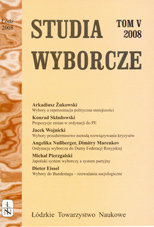System wyborczy jako ważna zmienna warunkująca kształt systemu partyjnego w Japonii
ELECTORAL SYSTEM AS AN IMPORTANT VARIABLE DETERMINING STRUCTURE OF JAPANESE PARTY SYSTEM
Author(s): Michał PierzgalskiSubject(s): Politics / Political Sciences
Published by: Łódzkie Towarzystwo Naukowe
Summary/Abstract: Japanese post-World War II party system is dominated by one political party. Since 1955 Liberal-Democratic Party (LDP) has stayed in power except a short period between August 6, 1993 and June 29, 1994, during which 7 parties in the Diet formed a coalition cabinet without the LDP. The biggest puzzle of Japanese politics is why LDP has stayed in power for so long. Many analysts say that Japanese electoral system before 1996, namely SNTV (single nontransferable vote) with MMD (multi-member district) system, has fostered one-party dominance by the LDP. In this paper I argue that Japanese party system is contingent upon electoral system. Besides, there are at least two other types of explanations for phenomenon of LDP’s absolute dominance, especially political culture explanation and political economy explanation. Thus, we can distinguish at least three theoretical approaches describing peculiar features of Japanese post-war party politics. This paper focuses on the role of electoral system in determining format and mechanism of Japanese party system. I argue that explaining effects of electoral law is a key to understanding Japan’s post-war party politics.
Journal: Studia Wyborcze
- Issue Year: 2008
- Issue No: 05
- Page Range: 75-97
- Page Count: 23
- Language: Polish

